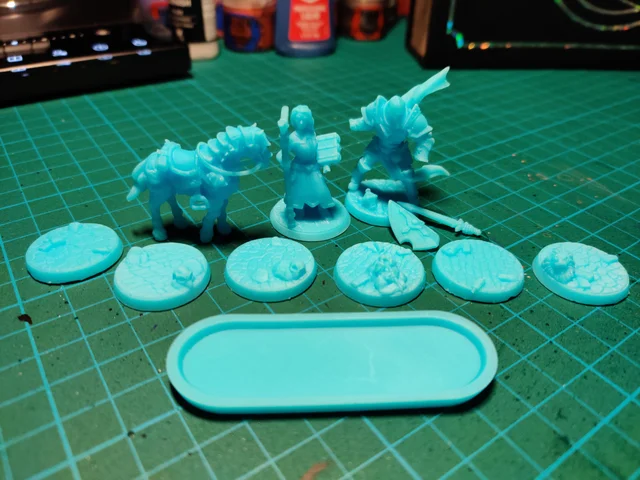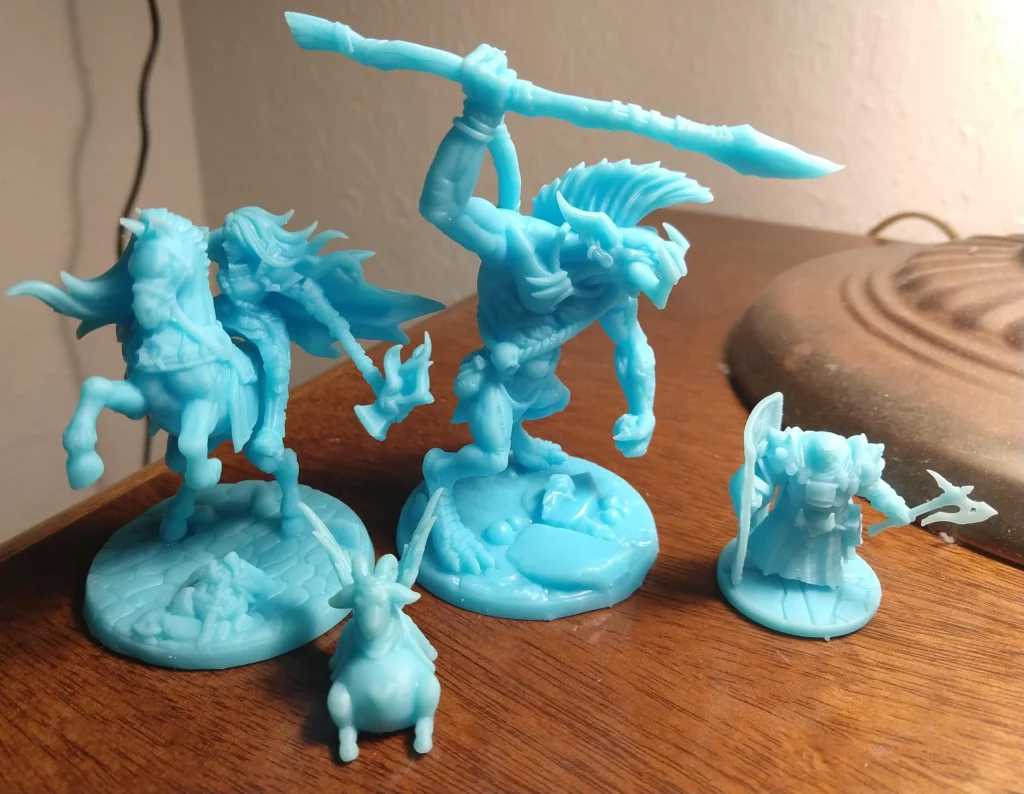Given the vast array of options available today, choosing the best resin for your 3D printer might be challenging. Many resins have special qualities that make them more practical and approachable. One such resin is Anycubic Eco, which is produced by a reputable 3D printer company. Due to its environmentally sustainable nature, Anycubic Eco Resin is a well-liked and top-rated resin for SLA 3D printers. This resin is unquestionably worthwhile to try, whether you’re an expert or a novice.
The resin has an advantage over other conventional polymer resins because of the low odor, wide color variety, better robustness, fine detailing, low cost, and much more. However, cleanup can get pretty messy because it is a liquid resin. Settings for this resin also vary from printer to printer and based on colors too.
Keep reading to find out more eon the Anycubic plant-based resin!
Anycubic Plant-based Resin

The Anycubic Eco Resin is manufactured by a company known for producing high-quality and efficient MSLA 3D printers. You can anticipate outstanding customer support and first-rate consistency from a brand like this.
You are not limited to Anycubic machines because this resin is usable with all 3D printers that use third-party resins.
This resin may be bought in 500-gram and 1-kg bottles and comes in a variety of colors, enabling the printing of products like miniatures, jewelry, and other adornments for the home.
Only a limited few items can compare to the Anycubic Eco Resin in terms of cost and value for money. The Anycubic Eco Resin is a non-toxic, eco-friendly answer to every one of your resin printing needs.
Related: 8 Best 3D Printer for PETG in 2022
Anyone interested in low odor, eco-friendly resin 3D printing can use the Anycubic Plant-Based UV resin as a sustainable and environment-friendly substitute for the majority of photopolymer resins currently on the market. The 355-410nm photopolymer resin used in LCD or DLP 3D printers is compatible with this plant-based resin.
Features of Anycubic Plant Resin
- Eco-friendly and biodegradable
- Printing with a very low odor
- Several Compatibilities
- Anycubic Photon Curing Time Optimization
- minimal shrinkage
- Rich, vibrant colors that are extremely safe
- Low-Range Wavelengths
- Superior Prints
- Numerous Applications
- Outstanding Fluidity, Long-Lasting Prints
Parameters of Anycubic Plant Resin
- Hardness: 84D
- Viscosity (25°C or 77F): 150-300MPa
- Solid Density: ~1.1 g/cm³
- Shrinkage: 3.72-4.24%
- Shelf Life: 1 Year
- Solid Density: 1.05-1.25g/cm³
- Wavelength: 355nm-410nm
- Bending Strength: 59-70MPa
- Extension Strength: 36-52MPa
- Vitrification Temperature: 100°C or 212F
- Thermal Deformation: 80°C or 176F
- Elongation at Break: 11-20%
- Thermal Expansion: 95*E-6
- Capacity: 500g or 1kg
- Bottom Layers: 5-10s
- Bottom Layer Exposure Time: 60-80s
- Normal Exposure Time: 8-10s
Low odor
The Anycubic Plant-Based UV resin’s minimal odor emission while printing is one of its main selling factors. The Plant-Based UV resin is touted as being a biodegradable substance that is predominantly made from soybean oil, in contrast to standard photopolymer resins.
Additionally, Anycubic touts the material’s compliance with the EN 71-3:2013 safety standard, a European Union standard that establishes regulations and test procedures for different components in any liquid or sticky toy substance.
Even when the printer’s lid was removed, the Plant-Based UV resin’s smell is noticeably less intense than that of other resins. This formulation offers a far reduced odor printing experience.
Miniatures

Despite being a more eco-friendly substance, the Plant-Based UV resin nevertheless needs a chemical bath to cure it because it needs to wash any excess off the model. To completely clean and cure the material, utilize 91% isopropyl alcohol and a two-minute cure time in a wash/cure station.
Related: Why Is My Anycubic Kobra Not Sticking to Bed? Answered
The figurines have clear, in-focus detailing.
The material is hard but not brittle after curing, and delicate features were able to be easily detached from the support framework without suffering any damage. The amount of precision that was resolved on these models is amazing, and it is obvious that this material can handle the small features.
Pros & Cons of the Anycubic Plant Resin
Pros
- Plant-based resin that has a very faint scent
- High-quality printing and quick curing
- Reasonably priced
- Top-notch usability
- More robust than conventional resin
- Disconnecting supports quickly
- Simple post-print soap and water cleaning
- Compared to other green resins, this one’s green tint is clear
- Fantastic for printing detailed models or miniatures
- Features a low viscosity and is easily poured.
- More sustainable than ABS and doesn’t release volatile organic compounds
- Works great right out of the box
- Outstanding build plate adhesion
- A well-known company with top-notch customer support
Cons
- Many people claim that the white Anycubic Eco Resin is fragile
- Due to the fact that you’re working with liquid resin, cleanup can be messy
- Some users have stated that the resin doesn’t turn out to be as clear as advertised and instead cures with a yellow hue
Best Settings for Anycubic Plant Resin
There are optimal Anycubic Eco Resin settings for several 3D printers. These are either endorsed by users who have had a good experience with them or by the company in the product description.
Related: Best Cura Profile Settings for Anycubic Kobra Max
Here are some well-known resin 3D printers and the Anycubic Eco Resin settings that have been used successfully by others.
Elegoo Mars
Based on the color of the Anycubic Eco Resin you’re selecting, the overwhelming majority of experts advise choosing a Normal Exposure Time of 6 seconds and a Bottom Exposure Time of 45 seconds for the Elegoo Mars.
Elegoo Mars 2 Pro
Many experts advise choosing a Bottom Exposure Time of 30 seconds and a Normal Exposure Time of 2 seconds for the Elegoo Mars 2 Pro. For Normal and Bottom Exposure Times, consult the Elegoo Mars 2 Pro Resin Settings Spreadsheet.
The Anycubic Eco Resin’s recommended values for a few other distinct colors are listed below.
White: 2.5 seconds for a normal exposure; 35 seconds for the bottom exposure.
Translucent Green: 6 seconds normal exposure; 55 seconds bottom exposure
Black: 10 seconds normal exposure; bottom: 72 seconds exposure
Elegoo Saturn
A decent range to explore with for your Normal Exposure Time on the Elegoo Saturn is 2.5-3.5 seconds. A Bottom Exposure Time of 30-35 seconds has also generally produced excellent results.
To gain a sense of the ideal Normal and Bottom Exposure Time ranges, consult the Official Elegoo Saturn Resin Settings Spreadsheet.
Anycubic Photon
Most users have had success with the Anycubic Photon using a Normal Exposure Time of 8 to 10 seconds as well as a Bottom Exposure Time of 50 to 60 seconds. The Anycubic Photon Resin Settings Spreadsheet for Normal and Bottom Exposure Times is available online.
Mono Anycubic Photon
The majority of users have reported excellent results with the Anycubic Photon Mono X while choosing a Normal Exposure Time of 2 seconds and a Bottom Exposure Time of 45 seconds. For Normal and Bottom Exposure Times, see the Anycubic Photon Mono X Resin Settings Spreadsheet.
The Anycubic Eco Resin’s ideal values for the various colors are listed below.
White: 5 seconds normal exposure; 45 seconds bottom exposure
Translucent Green: 2 seconds normal exposure; 25 seconds bottom exposure
Precautions
- Before using, shake the bottle, and keep it away from children, debris, and the sun.
- 25–30°C is the optimum temperature for use.
- Try printing in a location with good ventilation, and when handling the resin, protective gloves, and a mask.
- Once the model has been printed, clean it with ethanol alcohol or dish soap for a minimal 30 seconds.
Frequently Asked Questions
Is Anycubic’s plant-based resin toxic?
Anycubic advertises its plant-based resin as having no VOCs, no BPA, and no harmful chemicals. Hence, the plant-based resin is not toxic.
What is Anycubic’s plant-based resin made of?
The Anycubic Plant-Based UV resin’s minimal odor emission while printing is one of its main selling factors. The Plant-Based UV resin is touted as being a biodegradable substance that is predominantly made from soybean oil, in contrast to standard photopolymer resins.
Is Anycubic’s plant-based resin biodegradable?
Eco resin from Anycubic is manufactured from soybean oil, making it sustainable. It is also readily biodegradable. This resin is not only eco-friendly but also user-friendly because it doesn’t smell like other resins do.
Is it okay to mix plant-based resin with other resins?
The common assumption is that mixing different resins of the same type is not an issue and that using different colors and/or brands is acceptable as long as the resin type is the same.
Conclusion
In the end, the Anycubic Eco Resin is a great option for you to use while creating resin 3D prints. It’s not overly expensive, requires little calibration out of the box, and is entirely eco-friendly.
It has a reputation for reliability and produces prints of excellent quality. Additionally, it is fairly durable, which is not typical of conventional resins. Moreover, there are numerous shades from which to choose.
Its incredibly minimal odor is one of this resin’s finest qualities. Despite the fact that it’s advised to print in a well-ventilated location, you’ll be able to breathe easy knowing that the Anycubic Eco is at work.
Whether you’re a beginner or an expert in the field of resin 3D printing, investing in this resin will be worth your time and money.
